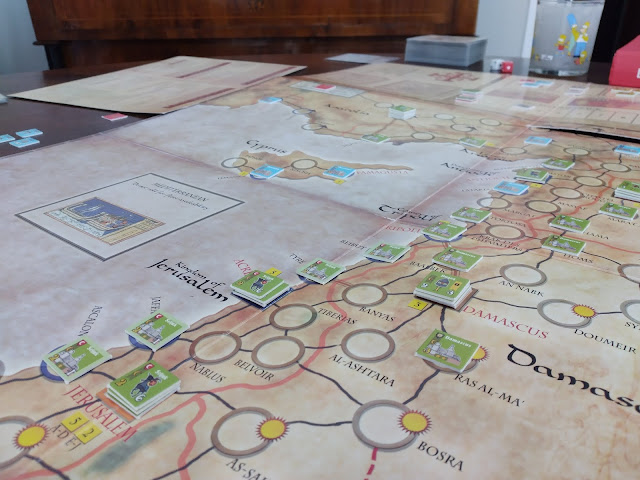Commands & Colors: Ancients. Ticinus of Blood
Romano: Alex Isabelle
Carthaginian: Laura Beltrami
We move to 218 BC, to the battle of the river Ticinus, the first direct confrontation between the Carthaginians and the Romans in the Second Punic War. Hannibal lost half an army in the Alps, and Publius Cornelius Scipio, father of what would later become known as Scipio the African, after keeping an eye on the Carthaginians for a while decides to try an engagement. What can these barbarians ever do on their little horses?
Well, they can fuck him, to begin with. Because those ponies are Numidian horses, led by commander Maarbal, who after the mythological Alpine crossing does not really have the right disposition to be denied access to Cisalpine Gaul, and therefore intends to offer resistance. How to blame him. The indomitable Mago, in turn leading a wing of Numidian cavalry, shares his opinion.
 |
| The premises. |
The clash between the Romans of Scipio and the Carthaginian cavalry, historically led by Hannibal, while here the scenario shows Hasdrubal (a typo?) takes place in the clearings adjacent to the Ticinus river. The two generals immediately offered a tactical challenge to their opponent.
The Carthaginians opted for an orderly advance, supported by a diversionary attack on the front facing the Ticino. The Romans, whose forces are composed largely of light cavalry and a good number of medium cavalry, partly Gallic, opted instead for a conservative approach. The first assaults of the cavalry were repelled. At the same time, the infantry began to do a series of hit-and-run attacks: the men ran forward shortening the distance that separated them from the cavalry, launched their attacks from a distance (I presume through the use of slings), and then they returned in order to the starting ranks. When the Carthaginian heavy cavalry finally advanced they persistently obscured the sky with their arrows, launching a flurry of attacks on the unit led by Hasdrubal himself.
 |
| We'll darken the sky with nothing. |
Unfortunately, all these attacks had a ridiculous effect: some horses ran away, some units made a poorly controlled retreat. Real losses: few. As the Spartans did against the Persians, therefore, the Carthaginians decided to fight in the shade: a first charge of the cavalry put a light infantry unit on the run; a second unit instead fell under the hooves of the Iberian horses, which made up the heavy cavalry of Hasdrubal. Publius Scipio risked his life, miraculously surviving a charge that eliminated the cavalry unit he was leading. Reached in extremis by a unit of slaves who were promised freedom in exchange for victory (light infantry), he managed to eliminate a surprising unit of Iberian horsemen, putting them on the run with the tenacity of desperation.
It must be said that the final charge of the Carthaginians was rather messy, and greatly disrupted the ranks of the latter, exposing the soldiers to the counterattacks of the surviving Romans, now devastated but well positioned in a circle of loyalists ready to do anything to bring home their skin. In the long run, this could have virtually been a problem for the Carthaginian, who at this point took a second loss on the side of the battlefield opposite the river, at the hands of the tenacious Roman cavalry.
Except that, in this game, people run away when there are too many deaths. And at this point, therefore, the Roman morale was so bad that it didn't take much to send them definitively in rout. Destroyed a Gallic cavalry unit, which fell victim to a sensationally well-coordinated (read: lucky) ranged attack, the Romans turned on their heels and fled like hell, leaving thousands of fallen soldiers on the battlefield.
A historically accurate ending, it must be said. In this sense, it awarded the greater control of the battlefield by the Carthaginian: not advancing exposed the Romans to sudden flight of their soldiers, which certainly contributed to their defeat. The final charge of the Iberian cavalry, which they tried to prevent by means of preventive ranged attacks, was a hammer to which not even the most tenacious of light infantry could have offered resistance.
Do you want to read other stories? Click here for the full list.
 |
| The beginning of the Carthaginian advance. |
 |
| Numidian cavalry. |
 |
| Romans. |
 |
| Move-Fire-Die. |



Comments
Post a Comment